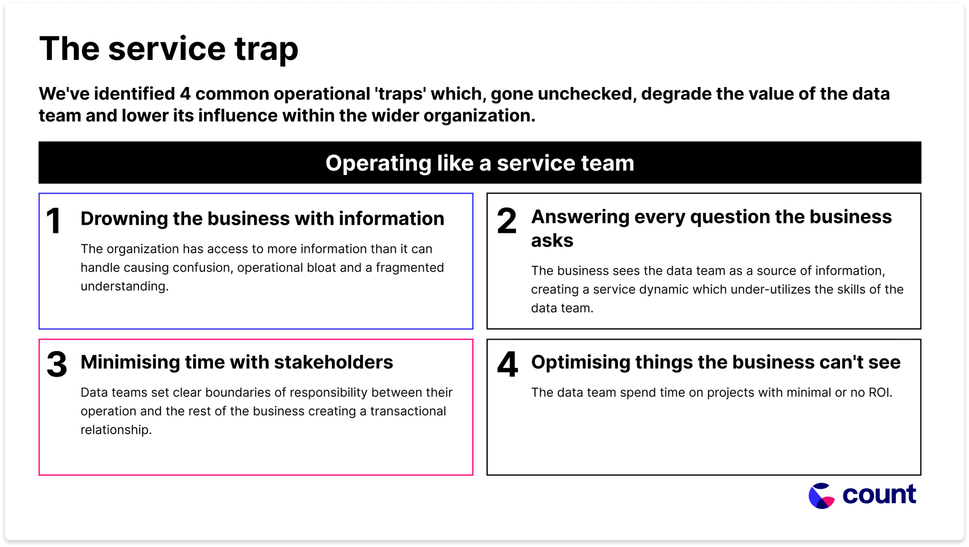How to re-establish trust in data
[YouTube Video: https://www.youtube.com/embed/NVqjNcbopUg]
[YouTube Video: https://www.youtube.com/embed/dQ4jY37Q90o?start=1640]
The other day I was posed with a problem by a member of ourSlack community:
“I’ve just joined a new company as a Head of Data and have noticed a serious lack of trust in the data. They don’t trust any of the reports and dashboards, and just want CSV exports for everything. I’m trying to figure out the best way to re-establish trust while also balancing the day job of keeping everything running. Any advice?”
So today’s article explores that problem and the advice I’ve gathered across several data leaders and teams in the last few weeks.
The importance of trust
Trust in numbers is paramount to a data team’s success. Without it, business teams aren’t confident in the numbers we provide, and our dashboards and reports go unused while spreadsheets continue to pile up. And in the worst cases, we become a service team on a mission to deliver CSV files as quickly as possible.

Not trusting the data can take on many forms. Maybe it is a data quality issue and your numbers are indeed out of date, or incorrect. However, it is just as often the case that the numbers are right but the expectations are misaligned.
Regardless of which type of mistrust you’re experiencing the key question is ‘How do you get it back?’
1. Be transparent (more than you think you need to be)
"At the end of the day, it is about transparency - regularly update the business on your status, and always be open to receive the information you need from them.” - Anonymous data leader
In Will Sweet’s 2023 MDS Fest talk, ‘The Why and How of Saying No’, he asserts that data teams must communicate differently depending on how much their organizations trust them. Organizations with high trust can get away with less detail, maybe a headline or single sentence of what they’ve found in some data, or a brief update on a big project.
However, data teams with low trust must provide the headline, the narrative,and the proof.
The clip below jumps to where Will mentions this:
What this looks like:
- Sharing your team’s goals and progress regularly.
Find reasons to get in front of your stakeholders and make your work visible, and understood.
“I implemented a new rigid process for every piece of analytical work that we do, to make sure we catch data quality issues early. I am now presenting that process and how it’s going to the entire company to make sure they have ultimate visibility.” - Anonymous data leader
2. Sharing the method, not just the results
For every question, request, report, or dashboard, take the time to explainhowyou got to that answer, not just the answer.
“We started meeting with stakeholders as often as we could to explain how their dashboards were built, what their metrics definitions were from our side. We had to go through at a low-level of detail to regain that trust.” - Anonymous data leader
Over time, this should become less and less necessary, but this exercise goes a long way in re-establishing trust in existing reports, and any new outputs you produce.
Note: This is often difficult in BI tools because it’s separate from where the analysis is done, or where the modeling is done. This is where Count shines so I would be remiss not to mention it here.
2. Get stakeholders involved sooner
It’s difficult to trust something that you had no hand in building. Most stakeholders only interact with a data request through the initial request form or Slack message. Then a few weeks later they are given a dashboard that’s meant to be the answer to all their questions.
It would be difficult for any of us to trust data that was thrust upon us so suddenly.
High-trust data teams counter this by bringing their stakeholders into the analytical process.
“As analysts and report-builders we’ve gotten into the habit of pitching a report. We build it then say ‘Here you go!’ as if this is our pitch. But this is our product. We want you to love it. We should be inviting them into the whole process, having a conversation rather than just presenting something at the very end.” - Sara Sabzikari
What this looks like
- Getting rapid feedback (Agile > Waterfall)
In this example, Veronika Cucorova, Data Engineer at Otrium, shares an example of how getting rapid feedback helped her build a better pricing model in a fraction of the time. Not only that, but the downstream model was more trusted because it had been built with so much input from stakeholders.
- Make yourself visible by holding regular check-ins
As we mentioned in our article last week on operational clarity, holding regular metric meetings with your stakeholders is a really valuable practice for curating more trust and understanding.
“We make ourselves visible so we can proactively ask them about their needs.” - Anonymous data leader
3. Enabling and encouraging curiosity
While it’s easy to get frustrated when your stakeholder starts sifting through your data in a spreadsheet, it is ultimately a sign that they are curious and motivated to use data. The best data teams don’t stifle that curiosity but rather cultivate it, albeit with certain guidelines in place.
“
What this looks like
- Don’t gate-keep data. Help people use it better.
- Handling ad-hoc requests well (see our articleon that)
What’s missing?
While there are some great ideas in here, I’d love to hear if you have any others. If so, I’ve made a call for ideas on LinkedIn, or feel free to DM me if you prefer!